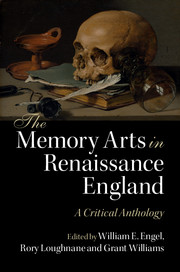Book contents
- Frontmatter
- Dedication
- Contents
- List of figures
- Acknowledgements
- A note on abbreviations
- Introduction
- PART I The art of memory
- PART II Rhetoric and poetics
- Introduction to Part II
- II.1 Anon., Table of Cebes (1531)
- II.2 Thomas Wilson, The Art of Rhetoric (1553)
- II.3 George Puttenham, The Art of English Poesy (1589)
- II.4 Henry Peacham, The Garden of Eloquence (1593)
- II.5 Philip Sidney, The Defence of Poesy (1595)
- II.6 Francis Meres, Palladis tamia (1598)
- II.7 Samuel Daniel, Musophilus (1599)
- II.8 Miles Sandys, Prudence (1634)
- II.9 Ben Jonson, Timber, or, Discoveries (1641)
- II.10 Alexander Ross, Mystagogus poeticus (1648)
- PART III Education and science
- PART IV History and philosophy
- PART V Religion and devotion
- PART VI Literature
- Index
- References
II.2 - Thomas Wilson, The Art of Rhetoric (1553)
from PART II - Rhetoric and poetics
Published online by Cambridge University Press: 05 August 2016
- Frontmatter
- Dedication
- Contents
- List of figures
- Acknowledgements
- A note on abbreviations
- Introduction
- PART I The art of memory
- PART II Rhetoric and poetics
- Introduction to Part II
- II.1 Anon., Table of Cebes (1531)
- II.2 Thomas Wilson, The Art of Rhetoric (1553)
- II.3 George Puttenham, The Art of English Poesy (1589)
- II.4 Henry Peacham, The Garden of Eloquence (1593)
- II.5 Philip Sidney, The Defence of Poesy (1595)
- II.6 Francis Meres, Palladis tamia (1598)
- II.7 Samuel Daniel, Musophilus (1599)
- II.8 Miles Sandys, Prudence (1634)
- II.9 Ben Jonson, Timber, or, Discoveries (1641)
- II.10 Alexander Ross, Mystagogus poeticus (1648)
- PART III Education and science
- PART IV History and philosophy
- PART V Religion and devotion
- PART VI Literature
- Index
- References
Summary
About the author
Thomas Wilson (1523–81), a Protestant humanist, fled England when Mary I gained the throne. Upon his return in 1560, he put his legal and rhetorical training to good use, climbing the social ladder as an interrogator, a parliamentarian, a diplomat, a Privy Council member and a secretary to Elizabeth I.
About the text
A companion piece to his manual of Scholastic logic The Rule of Reason (1551), Wilson's Art was the most popular Elizabethan treatise on rhetoric in English. It underwent eight printings during the sixteenth century. It was also the most comprehensive English rhetoric in the period, its three books encompassing Cicero's five oratorical canons: the first dealing with invention, the second with invention and disposition, and the third with style, memory and delivery. Dedicating the book to John Dudley, Earl of Warwick, eldest son of the Lord Protector, Wilson aims to assist the governing elite and lawyers rather than would-be courtiers. Along with his compatriots in the Cambridge circle – the humanist scholars surrounding John Cheke – Wilson contributes to the national project of translating classical knowledge into vernacular forms and promotes an authoritarian view of rhetoric consistent with conservative orthodoxy in the service of building and defending a Protestant English state.
The arts of memory
Wilson's section on the art of memory rehearses many of the art's commonplaces, including the division between artificial and natural memories, the roll call of classical mnemonists and Simonides's invention of the art. This excerpt, less cloyed with convention, follows instructions on how the art of memory deploys images and places. Wilson anticipates sceptical objectors to the art through expanding upon Quintilian's observation that sites we physically visit conjure up previous experiences and thoughts. Our entire world rouses our recollection as a memory palace does, everyone, no matter his class position, putting into practice the art. As the argument unfolds, Wilson concludes that it naturally makes sense to exploit the full potential of an artificial memory by exercising the discipline systematically to create images as well as places. To illustrate the evocative power of the locus, he recounts the exemplum of a priest whose execution prompts an elegiac remembrance. The exemplum with its haunting citation of the Psalms provides a philosophical or, rather, theological comment upon place logic.
- Type
- Chapter
- Information
- The Memory Arts in Renaissance EnglandA Critical Anthology, pp. 113 - 116Publisher: Cambridge University PressPrint publication year: 2016



